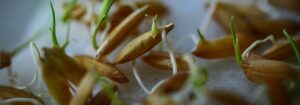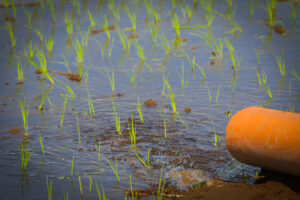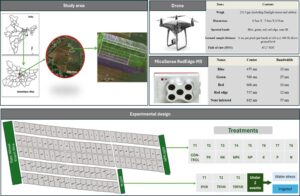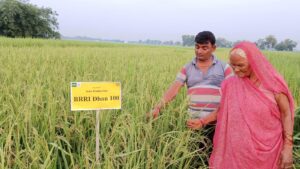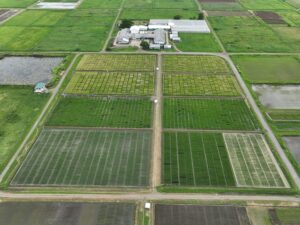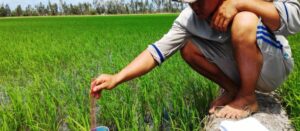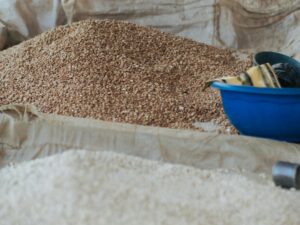César Puerto’s half-hectare rice plot yields him 3 tons of grain each harvest. Mr. Puerto has dedicated 10 of his 32 years to growing rice. It provides a living for him, his brother, sister-in-law, and two nieces, who help sow and harvest the crop on this small farm, located at the end of a dusty road.
His neighbor, veteran grower Marina Mejía, with 30 hectares, produces 300–360 tons of rice each season. Mrs. Mejia has been working her land for nearly 3 decades. “Thanks to rice, I’ve been able to raise my four sons and nine grandchildren,” she says proudly.
Since there are two cropping seasons each year, the combined average of more than 600 tons of rice that Mr. Puerto’s and Doña Marina’s farms produce annually near the town of Sinamal in Rioja Province of Peru’s San Martín Department contribute to rising national production, which reached 3.1 million tons in 2013. Peru now accounts for 12.25% of South America’s total rice output, which amounted to 25.3 million tons in 2013, making this country the region’s second most important producer after Brazil, according to the Food and Agriculture Organization of the United Nations (FAO).
About 380,000 hectares are sown to the crop in this country, with an average yield of 7.7 tons per hectare, which is well above the regional average of 5 tons, says Orlando Palacios, head of the National Rice Program at Peru’s National Institute for Innovation in Agriculture (INIA). In coastal areas, such as Piura and Arequipa, some growers obtain yields as high as 16 tons per hectare–among the highest in the world.
Secrets to success
So, what’s the secret to Peru’s abundant rice harvests? For Mr. Puerto and Mrs. Mejia, the answer is clear.
“This is sacred ground—so rich in nutrients that we don’t have to apply much fertilizer,” says Mr. Puerto, who also believes that La Esperanza, the variety he’s been planting for years (and whose name means “hope”), plays a big role in the success of rice on his land.
Looking beyond local perceptions, plant breeders such as Carlos Bruzzone, the director for research and development at Hacienda El Potrero SAC, a company producing certified rice seed, cite other reasons for Peru’s high rice yields. Significantly, 84% of the area sown to the crop is irrigated, and it is also favored by high amounts of sunlight and limited rainfall. On an estimated 50% of the irrigated area, climatic conditions are just right for high yields. Dr. Bruzzone further believes that transplanting of seedlings, the method used most commonly to sow rice in Peru, contributes importantly to rising output.
Eduardo Graterol, the executive director of the Latin American Fund for Irrigated Rice (FLAR), cites other factors, particularly the adoption of modern varieties with high yield potential and resistance to pests and diseases, together with tolerance of environmental stresses as well as the use of certified seed on about 50% of the cultivated area.
Dreaming of exports
James Pinedo is the president of the Rice Producers Association of Jaén and San Ignacio, which has 88 members. All members have the same dream: that a part of the nearly 100,000 tons of rice their farms produce each year will someday cross national frontiers.
“Our biggest ambition is to export rice and to do so directly with no intermediaries,” says Mr. Pinedo.
According to INIA, it is within Peru’s capacity to produce some surplus for export. Currently, between 300,000 and 350,000 tons of white rice are already being exported informally to neighboring countries. Nonetheless, to fulfill the export ambitions, small- and medium-scale growers, who have less than 20 hectares and are estimated to account for 68.9% of the country’s rice production, together with large producers, representing 31.1%, will need to meet certain quality conditions in order to compete internationally.
For Edgar Torres, the leader of the Rice Program at the International Center for Tropical Agriculture (CIAT), it’s important for the rice sector to invest more crop management practices that help realize the genetic potential of improved varieties that are already available, and that of new hybrids, which CIAT and FLAR are developing through the Hybrid Rice Consortium for Latin America and in Peru with Hacienda El Potrero. Dr. Torres also emphasizes the need for more site-specific crop management (based on big-data approaches to the use of soil and other data) as a strategy for boosting rice yields to 3 tons per hectare above the regional average, while adapting production to the impacts of climate change.
“Already high yields and the innovative capacity of Peru’s farmers and the private sector are key conditions for making our production more competitive,” says Jonatan Requejo, manager of Hacienda El Potrero. “The challenge ahead is to strengthen the ability of the rice industry to open windows for exports.”
In addition, growers need new production technology and farm machinery plus the support of national and local government to make credit, training, and technical support more widely available in rural areas.
Beyond potato
Per capita consumption of rice in Peru is high at 60 kilograms per year, on average. Rice has surpassed potato and is the preferred food on Peruvian menus today. About 7% of the rice consumed is imported, with Uruguay supplying 81% of the imports, Brazil 9%, Argentina 6%, and the rest coming from other countries.
“Peru imports rice for class A markets with high prices,” says Mr. Requejo. “We don’t have varieties that can compete with imported rice, which varies between 80,000 and 150,000 tons per year.”
For now, the scientists will continue to release new varieties— and, in the future, rice hybrids—that can surpass the varieties IR43 and INIA-La Esperanza (based on an elite line from CIAT) and subvert their rule in Peru’s rice fields. In the meantime, small, medium, and large producers will continue building knowledge and investing resources for them to take advantage of the hidden properties of Peruvian soils.
_________________________________________
Ms. Varón Molina is a communications coordinator for Latin America and the Caribbean at CIAT.

